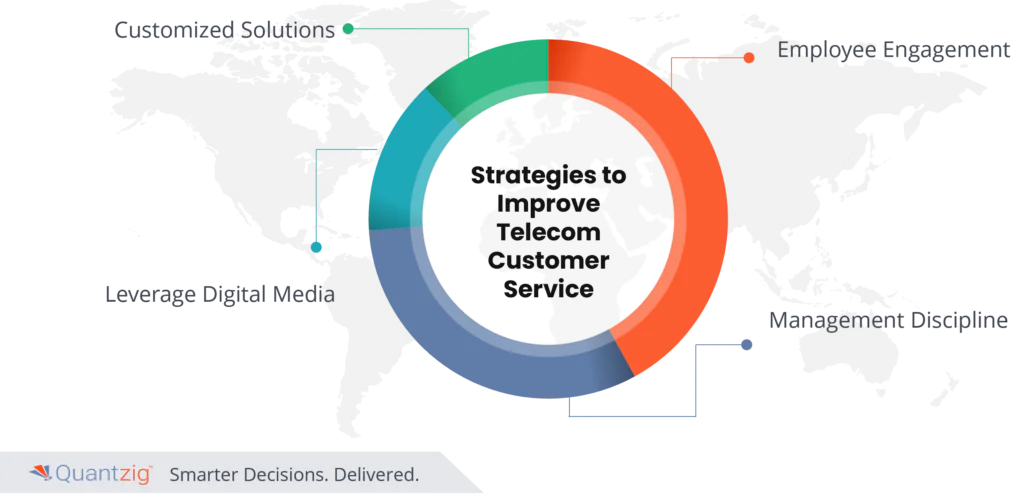Table of Contents
Introduction to telecom customer services
The telecommunications industry has undergone a remarkable transformation over the past decade, becoming an integral part of our daily lives. With heightened competition and hyper-consumerization, telecom companies face the challenge of retaining customers in an era where choices abound. Customer churn rates have surged, making customer service a critical aspect of sustaining and growing in this dynamic landscape. In this comprehensive exploration, we delve into the strategies that telecom companies can employ to elevate their telecom customer service, ensuring not only customer retention but also fostering brand loyalty.
Book a demo to experience the meaningful insights we derive from data through our analytical tools and platform capabilities. Schedule a demo today!
Request a Free DemoCustomer Service for the Telecommunication experience
The telecom industry has come a long way from what existed a decade or two ago. The services provided by telecom companies are largely a part of our everyday lives. Today, the telecom industry is witnessing an explosion of competition and an era of hyper-consumerization. Consequently, there has been an enormous increase in the rate of customer churn for telecom companies.
Modern customers are far more informed than before. As the competition intensifies, the customer is spoilt for choices. It is more challenging to acquire new customers, but even retaining your existing ones is not that easy. This calls for telecom companies to invest more in maintaining and retaining their existing customers through top-notch telecom customer service. What the players in the telecom industry need to primarily focus on are the rapidly changing customer needs and sentiments. We have identified five strategies that telecom companies can put into practice to step up their customer service.
Strategies to Improve customer loyalty in telecom industry

1. Customized Solutions
Every customer has different communication needs. Hence, it is imperative that telecom companies continuously interact with them and interpret their usage patterns to offer them tailor-made plans to fill this inherent need. Telecom companies (Telcos) have to pro-actively move customers to plans that are more beneficial to them and instead of giving more emphasis to the ARPU (Average Revenue Per User). This improved telecom customer service strategy will build customer loyalty and satisfaction towards the brand.
2. Employee Engagement
Telecom companies have various departments like marketing, network, admin, credits, verification, collection, and HR. Some of these departments rarely or never interact with the company’s customers directly, unlike sales and customer service. It is necessary to engage all these departments with the customers as frequently as possible. This will help them understand the customer’s pain points and perspectives. Consequently, it will promote better-coordinated effort and solutions to manage internal conflict and quicker resolution, and enhanced telecom customer service. The customer should be at the center of all cross-functional priorities.
3. Leverage Digital Media
Customers often resort to various social channels to report bad customer service and experiences. Keeping tabs on such instances is more important for a brand today than ever before as they have the potential to tarnish the brand’s image and dip the sales. In the case of telecom companies’ customers, it may be about the network, delay in response, billing issues, deactivation, and interaction with touchpoints or call centers. Most prospective customers read through feedback before they decide to opt for an operator. Using this will enable you to not only serve your existing customers well by providing them with an enhanced customer experience but also reach out to potential customers.
4. Management Discipline
All managers must be encouraged to practice customer service management and the results should be quantified. Most managers tend to work like technicians while working on data, rather than looking at it from the responsibility and knowledge perspective. Their actions should give positive results. Managers of telecom companies must have customer service traits inculcated into their work culture. Their only responsibility should be to make the company deliver the purpose for the sake of which it exists, and telecom exists only for the sole purpose of delivering efficient and effective customer service.
Get started with your complimentary trial today and delve into our platform without any obligations. Explore our wide range of customized, consumption driven analytical solutions services built across the analytical maturity levels.
Start your Free Trial TodayHow Old-school business practices are the barrier to better consumer behavior in telecom industry?
Telecommunications companies provide services to a wide range of customers, from individual consumers to multinational corporations and business partners of all sizes in between. According to a recent report, one of the biggest challenges telecom providers currently face is delivering connected, personalized experiences across this diverse customer base. This includes B2B companies, which are increasingly expecting the same kind of seamless digital experiences that consumers receive – something the telecom industry has historically been reluctant to provide.
The root of this issue lies in outdated business practices and legacy technology systems. Typically, each business unit within a telecom company relies on its aging IT systems. Employees must toggle between multiple platforms to access the data they need to serve clients. As a result, fragmented data leads to disjointed service, manual processes, delays, and errors – all of which culminate in unsatisfactory customer experiences.
Another challenge is that telecoms often incentivize individual business unit performance, which further entrenches silos and reduces the desire to share data and insights between teams. These business practices prevent telecom organizations from prioritizing the customer.
Communication providers realize they can’t win when old-school business practices are standing in their way. Many embrace an overarching mission to prioritize the customer. This includes investment in technology infrastructures to give teams a common data language. And, to encourage collaboration, the report recommends that providers should offer incentives for teams across the enterprise to work together to achieve shared goals.
Real-time insights help to understand the customer experience
The report discovered that most telecommunications companies have abundant data regarding service delivery performance but lack ways to utilize that data to improve customer satisfaction. Although performance metrics support assessing the customer experience, many telecoms need to expand their capacity to gather data on the complete customer journey.
Telecoms should also collect anonymous, straightforward feedback from both customers and customer-facing employees, as well as identified feedback. This will enable clear follow-up to pinpoint cases where the customer endured issues and develop suitable action plans.
If a long-standing customer needs a replacement for their shattered smartphone but is not yet due for an upgrade and the sales rep won’t make an exception, loyalty is at risk. Frustrated and unwilling to pay to repair the phone, the customer may switch providers (and get a better deal in the process). If the sales rep had the data they needed about the customer at the onset of the customer interactions, they could’ve found a solution that satisfied both the company and the customer. The expectation of the customer combined with the data and organizational silos result in what the report calls a “lack of true understanding of who their customer has become.”
To enhance customer service in the telecom sector, it’s crucial to focus on customer retention and loyalty while maximizing customer lifetime value through improved telecom customer experience. Utilizing advanced data analytics methodologies and partnering with Big Tech companies can provide valuable insights into customer churn patterns and preferences, enabling targeted strategies to foster customer loyalty. By staying ahead of competitors through superior customer service and offering a seamless customer journey, telecom companies can address customer experience problems proactively, leading to reduced customer churn. Prioritizing network optimization and leveraging cutting-edge data analytics technologies ensure efficient operations and enhance overall customer satisfaction, ultimately driving success in the competitive telecom landscape.
What contributes to telecoms customer experience?
Business practices are continuously refined to optimize service delivery performance and bolster sales rep effectiveness. Integral to this optimization is the implementation of a robust Digital Business Support System (BSS) and a comprehensive Customer Relationship Management (CRM) platform, facilitating a 360-degree view of the customer for personalized interactions and streamlined asset history tracking. Through network usage analysis and personalization, telecom companies strive to deliver superior service and foster proactive communication to drive both acquisition and retention.
Data plays a pivotal role, necessitating stringent data masking practices to adhere to GDPR guidelines while leveraging both customer data and non-customer data to understand home location, geographical footprints, and network traffic. Insights gleaned from various sources, including social media providers, online data, and competitor pricing, inform strategic decisions tailored to local demographics and weather patterns, optimizing offerings across consumer revenues spanning communications and entertainment.
Through predictive capabilities and machine learning (ML) algorithms, telecom companies anticipate customer needs and capitalize on opportunities for upselling and product development, driven by a deep understanding of usage patterns and competitor promotions.
Digital channels, including marketing email and tailored data plans, facilitate targeted engagement, while cross-functional collaboration between product development teams, data scientists, and customer support ensures alignment with key takeaways and maximizes financial benefit from in-life usage insights. The convergence of data management practices and advanced analytics, including A3 (analytics, automation, and artificial intelligence), empowers telecom providers to deliver predictive care and refine revenue models through incremental revenue opportunities, supported by a robust digital tech stack and meticulous attention to the quality and quantity of data.
AI and customer experience
AI stands as a transformative force, reshaping customer service and enhancing customer experience. Leveraging advanced data analytics methodologies and technologies, telecom companies harness the power of AI to optimize network performance, predict customer churn, and tailor customer journeys for enhanced customer retention and loyalty. By analyzing vast volumes of data, AI algorithms identify patterns in customer behavior and preferences, enabling personalized interactions and proactive interventions to address customer experience problems swiftly.
Through predictive modeling, telecom providers can anticipate customer needs and deliver targeted offerings, fostering long-term relationships and maximizing customer lifetime value. As AI continues to evolve, telecom companies gain insights into competitors’ strategies and market trends, driving network optimization and ensuring unparalleled customer satisfaction. Through AI-powered solutions, telecom providers achieve reduced customer churn, fortified customer loyalty, and set new benchmarks for excellence in customer service within the dynamic realm of Big Tech.
The report indicates that most communications service providers think AI will be crucial for customer experience. Specifically, 90% view AI as being important or moderately important for retaining customers and fostering loyalty. Moreover, over half believe AI has a very significant role to play in providing superior service and proactive outreach.
AI allows communications service providers to examine their data and gain insights to enhance the overall customer interactions and customer experience. This could involve proposing steps to resolve service problems or showcasing tailored products when customers shop online. AI assists with both acquiring new customers and retaining existing ones.
But you also need to make sure that the data is protected, or customer trust will be quickly broken – and trust is the most important value when it comes to customers. The Trends in Ethical Marketing from Salesforce found that 86% of customers are more loyal to ethical B2B companies.
Rules and safeguards such as data masking – the process of replacing sensitive data with anonymized data to protect sensitive or private information complying with privacy requirements – need to be built in. You can also use masking to ensure you’ve eliminated all personal data when writing AI prompts or training an AI model.
Experience the advantages firsthand by testing a customized complimentary pilot designed to address your specific requirements. Pilot studies are non-committal in nature.
Request a Free PilotConclusion
In conclusion, the telecommunications industry’s success hinges on robust customer service strategies that address the unique challenges posed by a highly competitive and consumer-driven environment. By embracing personalized solutions, fostering employee engagement, leveraging digital media, and instilling management discipline, telecom companies can elevate their customer service, ensuring not only customer retention but also the cultivation of brand loyalty. Simultaneously, predictive analytics emerges as a transformative force in healthcare, offering early disease detection, analyze disconnected data, personalized treatment plans, resource optimization, risk stratification, and improved patient engagement. The strategic integration of these practices reflects a commitment to customer-centricity and data-driven healthcare, marking a paradigm shift towards more efficient and patient-focused industries.





